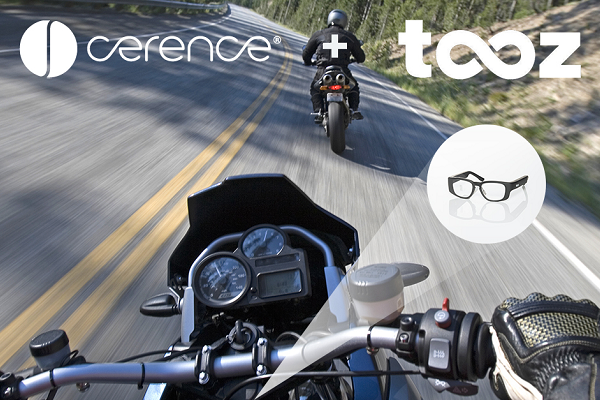Cerence Announces Smart Glasses Partnership for Motorcycle Voice Assistant
 Cerence sees a place for smart glasses as a platform for its virtual assistant on motorcycles. As the transport-focused custom voice assistant-maker works on building its services for two-wheel vehicles, it is partnering with tooz technologies to integrate its audio and visual assistant into the tooz Smart Glasses.
Cerence sees a place for smart glasses as a platform for its virtual assistant on motorcycles. As the transport-focused custom voice assistant-maker works on building its services for two-wheel vehicles, it is partnering with tooz technologies to integrate its audio and visual assistant into the tooz Smart Glasses.
Cerence Sees
The Cerence Mobility Platforms launched at the beginning of the year opened up new horizons for Cerence’s voice assistant. Released as part of the company’s Cerence Drive 2.0 revamp, the new platform aimed at bringing conversational AI to two-wheel vehicles, elevators, and anything else that moves but isn’t a standard four-wheel car. For motorcycles, Cerence is looking at smart glasses to provide an interface with the Cerence 2-Wheeler Mobility Platform.
Zeiss and Deutsche Telekom collaborated to start tooz (deliberately never capitalized) with the goal of making low-cost and discreet smart glasses with digital virtual screens. Cerence is banking on the tooz Smart Glasses as the solution for providing visual and voice-based interactions with Cerence’s virtual assistant, adapted for the limitations and safety requirements of a motorcycle. Smart glasses keyed to a motorcycle by Bluetooth would let the driver interact with the AI entirely hands-free, using just their voice. The lenses, using reflections and the tooz optical engine, could then display an image right on the wearer’s retina, displaying relevant information about upcoming traffic, speed limits, or potential weather problems without distracting the driver. The glasses are still under development, with tests in China and Germany underway.
“With this collaboration, Cerence and tooz are making a significant contribution to the future of mobility and the digital ecosystem,” Cerence Mobility Solutions senior vice president Charles Kuai said in a statement. “A safer and more enjoyable journey – that is not only our vision for everyone driving a car, but also for two-wheeler riders. We look forward to continuing our research and work with tooz to integrate voice and AI with smart wearables that can enhance the two-wheeler experience.”
Motorcycle AI
Motorcycle voice assistants have generally been considered in terms of full helmets, including Cerence when it first announced the initiative. That’s how Italian electric motorcycle manufacturer Energica is pursuing the idea, with a device placed into a helmet to talk to a smartphone connected to the motorcycle. Jarvish went for an all0-in-one look with a smart helmet that integrates Amazon’s Alexa voice assistant into its display. Honda, as the maker of motorcycles as well as AI, is looking at multiple controls for its motorcycles, with voice and handlebar switches operating the AI. Other motorcycles are adapting existing voice assistants. For instance, Harley-Davidson has a combination of screen and voice assistant-based control with Android Auto and Apple CarPlay controls available on different models.
The smart glasses approach offers some advantages over the other approaches. It can provide visuals as well as audio control, is cheaper than a full helmet-based device, and is more versatile than vehicle-only choices. Someone could use the smart glasses on the motorcycle, then get off and switch them to pedestrian mode, with whatever features and benefits the tooz incorporates into the device. That alone might mitigate the cost of the glasses.
“The application of smart glasses in the field of mobility is one of the most important and promising use cases for end consumers,” tooz CEO Kai Ströder said. “We are confident that the cooperation with Cerence will yield insights that will significantly shape the future of mobility and smart glasses.”
Follow @voicebotai Follow @erichschwartz
Cerence Expands Voice AI Platform to Motorcycles and Elevators
Italian Motorcycle Maker Energica is Developing a Voice Assistant for Riders
Harley-Davidson Motorcycles Will be First to Support Android Auto








